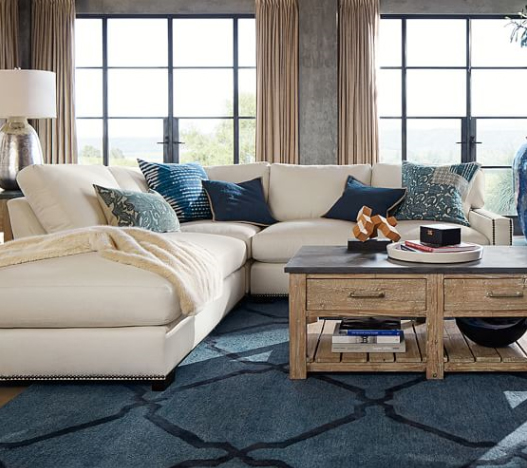
“I know my living room needs an area rug. But how do I know which size to get? How do I place my furniture around it and what are the best materials for area rugs?
Great question and I think many other are in the same boat as you. Area rugs creates warmth in a space, they also pull a room together – so they play a very important role. Area rugs can also add softness to a space and depending on what style you choose, they can act as ‘art’ on the floor by adding a big burst of colour and pattern into the space.
But picking the right size is crucial. A rug that’s too small will make the room feel small and an area rug that’s too big can chop off a room from the rest of the house. So how do you pick the right size and place it properly in the room? And which material do you choose?

Size of Rug
– start by measuring the room. Measure the width and the length. Then subtract 2-3 feet off of each measurement and that’s the size you should have. You can opt for something that is custom cut and bound and get (more or less) the precise size or make purchase of something that is close to the measurement you just calculated.
– standard rug sizes range from: 3×5, 5×8, 9 x12 (sometimes you can find odd sizes but these are standard). If you need a larger one or you have an oddly shaped room consider getting a piece of carpet cut to size and bound. It sounds expensive but it’s usually very affordable

Placement of Rug
– For a dining layout, measure the length and width of your dining table and add 2 feet on each side. Most dining room tables require a rug that’s at least 8 feet wide.
– For a bedroom layout, extend a rug from the bottom 2/3 of the bed. Alternatively, you could also place two runners on each side or a single runner at the foot of the bed.
– a good rule of thumb when deciding where to put a rug, make sure at least the front two legs of each piece of furniture in the space sit on the rug. Otherwise it can look like it is just floating and it won’t pull the room together

Material
– When it comes to ‘best’ material a lot of that really depends on what the room will be used for and the style. Wool rugs are the most expensive and they are top quality – they are soft, they wear well and they have a range of colours but you would want them to be cleaned by a professional so this probably isn’t a great option for say a kids’ playroom. Opt for a synthetic blend for a similar look that’s just as durable for a space like that
– Natural materials like sisal, jute and sea grass are very affordable and they are neutrals so they work with any colour scheme. Keep in mind they have a more casual look and they tend to be a bit on the scratchy side. A synthetic or nylon rug that has the same texture and look with be kinder on the feet. But if you want to get creative the natural sisal, jute or seagrass can be a great backdrop for a cowhide rug(see the image just above). It still pulls the room together and you get texture and then the pop from the cowhide.
– Flat woven kilim and dhurrie rugs are usually made of cotton or wool, are a fun way to add pattern to a room. But they are thin so they don’t hold up as well in the long run. They are best for low traffic areas but if you love the idea of updating your decor regularly with splashes of colour and don’t mind replacing the area rug every few years – this could also work for you
– Rug pads will also help prolong the life of your rugs and the floor underneath. You can find some very affordable rugs pads that will feel great and stand up to traffic. Plus it will help prevent the rug from slipping all over the place.

Pattern or Solid?
If your room got a lot going on, try a solid color or neutral rug to bring things down to earth—or make a basic sofa pop with a patterned rug.
Versatile Neutrals
A neutral rug forms a solid foundation when you want to layer on rich textures, patterns or colors. Think of it as the canvas for the rest of your room.
Playful Patterns
If your furniture is a solid color or neutral, try a patterned rug. For foolproof color coordination, match the
secondary color in the rug to your sofa or key furniture.
Solid Colors
A monochromatic rug complements patterned furniture by grounding it in a primary palette. In a living room, try matching the rug to the secondary color in a patterned sofa.
Area rugs really pull a room together …



